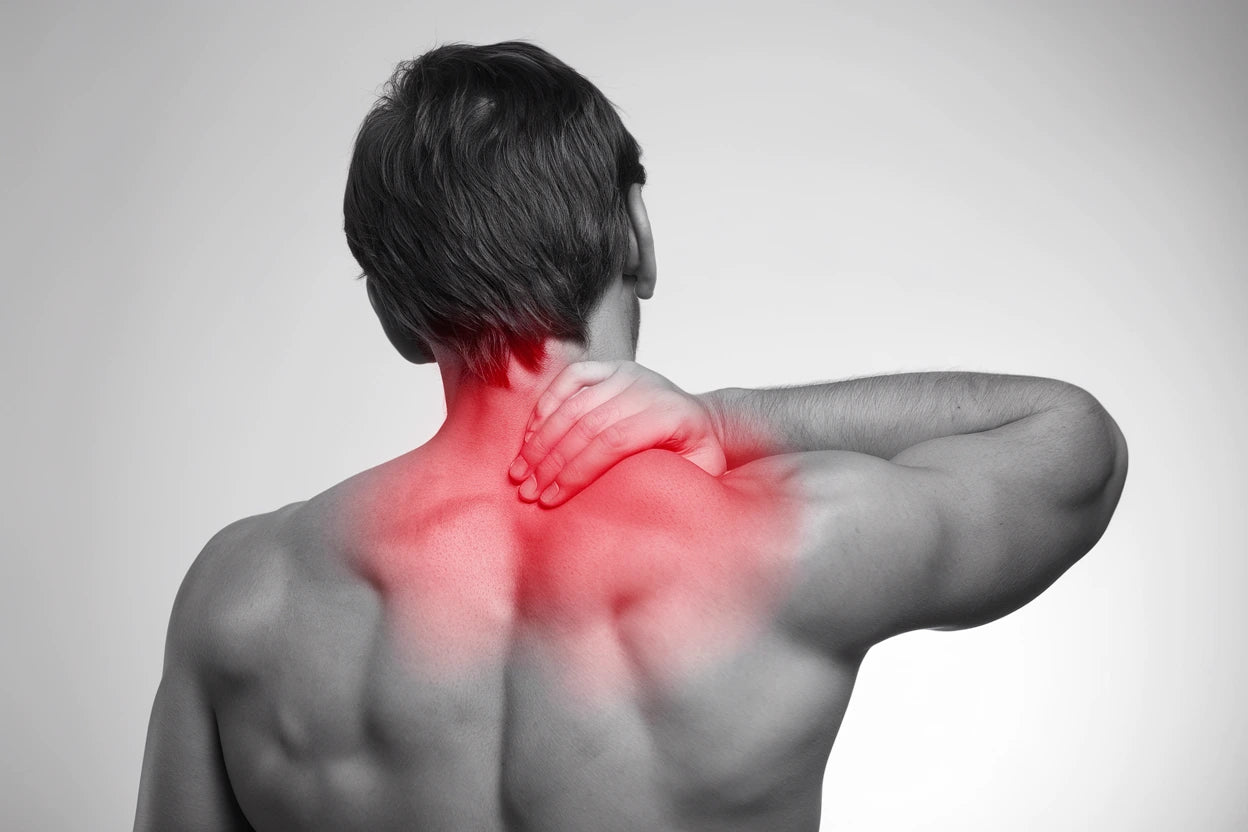Muscle Tension in the Neck: Symptoms, Causes, and Treatment

Muscle tension in the neck is a common problem that can cause discomfort and limited mobility. This article covers the most common symptoms, causes, and treatment options for muscle tension in the neck.
What is Muscle Tension in the Neck?
Muscle tension in the neck means that the neck muscles are overstrained and tense, which causes pain and stiffness. The condition is often caused by stress, poor posture, or overexertion. Rest, stretching, and ergonomic adjustments can alleviate the symptoms.
Symptoms of Muscle Tension in the Neck
Common symptoms include:
- Stiffness and tension in the neck and shoulders
- Pain in the neck, often more pronounced on one side
- Headaches, especially in the forehead or back of the head
- Limited mobility in the neck
- Tiredness in the neck and shoulders
- Soreness when touching the neck muscles
Pain from muscle tension in the neck is a very common issue that affects many people. The pain can occur suddenly or develop gradually over time. For many, it starts with mild stiffness that then evolves into more noticeable pain. Headaches are often a secondary symptom that arises when the muscles in the neck are tense for an extended period.
Tension in the muscles can cause recurring issues that sometimes manifest as pain radiating up towards the head or down towards the shoulders and back. In individuals with chronic muscle tension in their necks, symptoms may vary in intensity but rarely disappear completely without treatment.
Causes of Muscle Tension in the Neck
Several factors can contribute to muscle tension in the neck:
- Stress and psychological strain
- Poor posture, especially during prolonged screen work
- Overexertion of neck muscles
- Incorrect sleeping position
- Vision problems leading to strain on neck muscles
Stress is one of the most common causes of muscle tension in the neck. When we are stressed, we tend to automatically tense our muscles, often without being aware of it. Over time, this can lead to chronic tension and pain.
Poor posture, particularly due to long hours spent working at a computer or smartphone, is another common cause. When held forward for extended periods, this position puts strain on both cervical muscles and joints which can result in tension and pain.
The overexertion of cervical musculature may also occur due to repetitive movements or physically demanding work. Sometimes an improper sleeping position or unsuitable pillow at night can contribute to problems upon waking up.
Diagnosis and Treatment of Muscle Tension in the Neck
| Behandlingsmetod | Beskrivning | Fördelar med NackKomforten™ och Termoreliever™ |
|---|---|---|
| Stretching och övningar | Ökar rörligheten och minskar spänningar | NackKomforten™ stödjer under övningar |
| Värme- och kylterapi | Lindrar smärta och minskar inflammation | Termoreliever™ erbjuder både värme- och kylterapi |
| Massage och manuell terapi | Löser upp spänningar i musklerna | Kan kombineras med produkterna för bättre effekt |
| Hållningskorregering | Förbättrar nackens position i vardagen | NackKomforten™ stödjer korrekt hållning |

How NackKomforten™ and Termoreliever™ Can Help with Muscle Tension in the Neck
NackKomforten™ and Termoreliever™ offer several benefits for individuals with muscle tension in the neck:
- NackKomforten™ provides support and improves posture
- Termoreliever™ offers both heat and cold therapy for pain relief
- The combination can help reduce muscle tension and increase mobility
- The products can be used during both activity and rest for continuous support
- Contributes to faster recovery and reduced risk of recurring issues
NackKomforten™ is designed to provide optimal support to the muscles and structure of the neck. By using it regularly, it can help maintain better posture, reducing strain on the muscles in the neck and shoulders. This is especially beneficial for individuals who spend a lot of time in front of a computer or engaging in other activities that stress the neck.
Termoreliever™ provides options for both heat and cold treatment, offering flexibility depending on the type of discomfort. Heat therapy can be used to relax tense muscles, while cold therapy is effective in reducing inflammation and pain during acute conditions.
Conclusion
Muscle tension in the neck is a common issue that can often be alleviated with the right treatment and support. By combining self-care, appropriate exercises, and the use of supportive aids like NackKomforten™ and Termoreliever™, many individuals can effectively manage their symptoms and improve neck function. It is important to pay attention to the body's signals and seek professional help if symptoms persist or worsen.
With the right information and tools, most people can manage and prevent muscle tension in the neck. By identifying and addressing underlying causes, such as stress or poor posture, and complementing with appropriate aids, one can often see significant improvement in discomforts and prevent them from becoming chronic.
Frequently Asked Questions (FAQ)
How long do muscle tensions in the neck usually last?
Can stress cause muscle tension in the neck?
Yes, stress is a common cause of muscle tension in the neck and can exacerbate existing issues.
How do I use Termoreliever™ for muscle tension in the neck?
Use heat therapy to increase blood circulation and reduce tension, or cold therapy to decrease inflammation in acute conditions.
Can NackKomforten™ help prevent muscle tension in the neck?
Yes, by supporting proper posture, NackKomforten™ can help prevent strain and tension in the neck.
When should I seek medical care for muscle tension in the neck?
Seek medical attention if the tension persists, worsens over time, or if you experience other symptoms such as numbness or weakness in the arms.
